{title}
{publish}
{head}
Ahead of the trip to Havana, the Vietnam Journalists’ Association delegation met with Cuban Ambassador Rogelio Polanco Fuentes, who was introduced to me by journalist Le Quoc Minh, Editor-in-Chief of Nhan Dan and President of the association.
Upon learning I was from Quang Tri, the ambassador recalled a recent visit to the province, expressing deep admiration for its land and people, where President Fidel Castro had made a historic visit in September 1973 to encourage the Vietnamese army and people during Vietnam’s resistance war against the United States.
I told the ambassador that the Vietnamese people, especially those in Quang Tri, deeply admire Cuba’s revolutionary legacy. We honor the enduring solidarity of the Cuban people and Fidel Castro, as captured in his immortal saying: “For Vietnam, Cuba is willing to shed its own blood,” along with Cuba’s heartfelt support during the most difficult years of Vietnam’s struggle.
Latin American Press admire Cuba
Our delegation traveled to Havana to attend the 4th “Patria” International Conference on Digital Political Communication. The event featured the participation of Cuban Party and State leaders, alongside media delegations from Europe, Asia, and Latin America. The Vietnamese delegation was led by Nguyen Duc Loi, Standing Vice President of the Vietnam Journalists’ Association. Despite its geographical distance, Cuba, the island of freedom, felt remarkably close the moment we arrived.
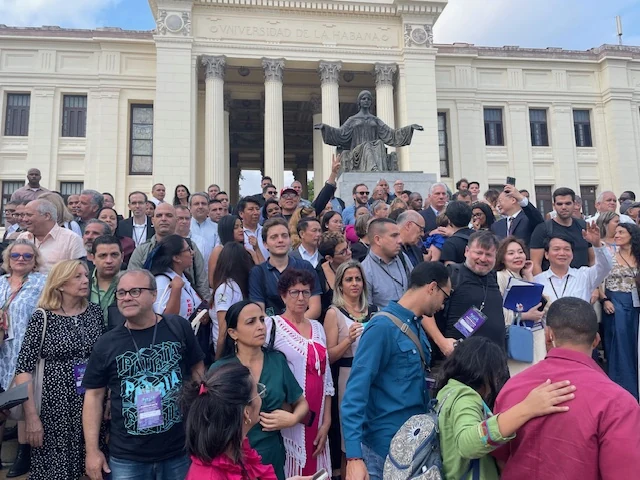
Many reporters around the world attend the event in La Habana. Photo: M.T
In Cuba, Patria is a renowned historic newspaper founded by José Julián Martí Pérez (1853–1895), a revered national hero. Martí was a nationalist, poet, philosopher, essayist, journalist, translator, professor, and publisher. He played a pivotal role in Cuba’s fight for independence from Spain and is considered one of Latin America’s greatest intellectuals. His body of work includes poetry, essays, letters, lectures, novels, and children’s publications. Martí contributed to numerous newspapers across Latin America and the United States, and also founded several newspapers of his own.
Martí’s newspaper, Patria, served as a vital tool in the campaign for Cuban independence. Following his death, several poems from his collection Versos Sencillos (Simple Verses) were adapted into the iconic Cuban song Guantanamera, which has since become one of the country's most emblematic and widely recognized anthems.
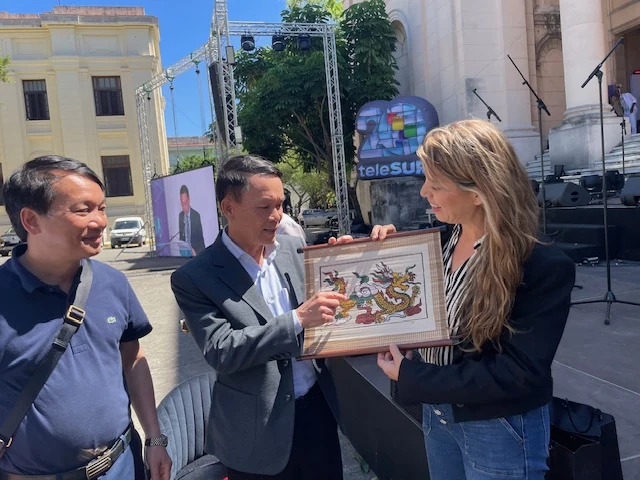
Nguyen Duc Loi, Standing Vice President of the Vietnam Journalists’ Association presents a Dong Ho folk painting to an editor of teleSUR. Photo: M.T
As part of the conference agenda, our delegation held a working session with the Cuban Association of Journalists. The meeting was hosted by the association’s President, Ricardo Ronquillo, and vice presidents, in an atmosphere that was open, sincere, and constructive.
Journalist Nguyen Duc Loi, Standing Vice President of the Vietnam Journalists’ Association, praised the substance of the 4th “Patria” International Conference on Digital Political Communication, organized by the Communist Party of Cuba, saying that the strong international attendance underscored the conference’s significance and global appeal.
Importantly, delegates shared valuable experiences in organizing media coverage that accurately reflects global and regional realities, especially efforts to counter the dominance and misinformation imposed by a number of Western press agencies for political purposes.
Loi said key events Vietnam will commemorate in 2025, including the 50th anniversary of national reunification, the 80th anniversary of the founding of the Democratic Republic of Vietnam (now the Socialist Republic of Vietnam), and the 100th anniversary of Vietnam’s revolutionary press.
He announced that 2025 will be designated the “Vietnam–Cuba Friendship Year,” marking 65 years of diplomatic ties between the two nations. He expressed hope that the Cuban Journalists Association and media organizations would help highlight this milestone through strengthened information exchange and bilateral cooperation.
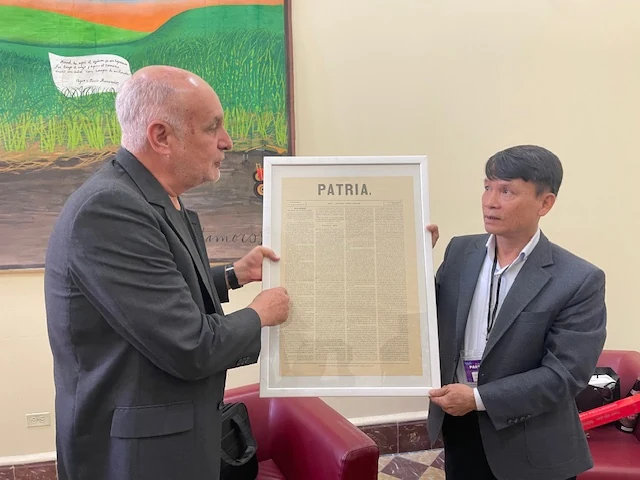
A leader of Patria, a renowned historic newspaper founded by José Julián Martí Pérez, presents a newspaper to Nguyen Duc Loi, Standing Vice President of the Vietnam Journalists’ Association. Photo: M.T
The leadership of the Cuban Association of Journalists affirmed their commitment to strengthening bilateral cooperation, highlighting Cuba’s willingness to publish valuable Vietnamese documents and publications in Spanish, and to send delegations for journalistic exchanges and professional collaboration.
“We thank the delegation from the Vietnam Journalists Association for participating in the seminar and delivering important remarks that captured the attention of the attendees,” said Ricardo Ronquillo, President of the Cuban Association of Journalists.
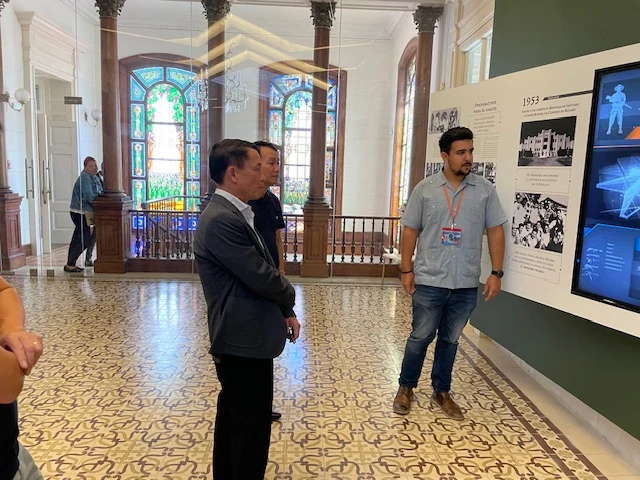
The Fidel Castro Center in La Habana. Photo: M.T
Earlier, following the opening ceremony at Mella Square, a memorial incense offering to Julio Antonio Mella, a prominent Cuban revolutionary and one of the founding figures of the Communist Party of Cuba, and a commemorative photo session on the steps of the University of Havana, the event continued with key speeches, seminars, media project presentations, workshops, and interactive sessions at the University of Havana Conference Center.
During a panel discussion, Nguyen Duc Loi, Executive Vice President of the Vietnam Journalists’ Association, addressed the topic: “Opposing media hegemony: Strategies from the Southern Hemisphere to counter Western media dominance.”
“It is no longer surprising that some Western countries are using the media as a tool to manipulate global politics in pursuit of their own political interests. Media hegemony has led to numerous negative consequences for society, restricting freedom of expression, creating inequality in access to information, and fueling social polarization.
That’s why resisting media hegemony is crucial to ensuring a more diverse and equitable information landscape. To counter or limit the dominance of Western media, countries in the Southern Hemisphere must develop an effective communication strategy. This includes raising public awareness about the importance of diverse perspectives, producing content that reflects real-world experiences, diversifying media platforms, enhancing the capacity of journalists, and building networks for cooperation and collaboration.
“In short, nations in the Southern Hemisphere must establish a strong, independent media system that reflects the truth on the ground, one that contributes to breaking the monopoly of Western narratives.”

Editor-in-Chief of Quang Tri Newspaper Truong Minh Duc Tu, left, meets leaders of Granma Newspaper. Photo: Quynh Anh
Loi’s speech received thunderous applause from participants, reflecting strong support for the Vietnamese delegation’s thoughtful and heartfelt remarks.
Outside, at Ignacio Agramonte Square on the University of Havana campus, a series of bilateral and multilateral meetings took place in quick succession. Echoing across the plaza were chants of “Viva Cuba! Viva Cuba!” — a powerful expression of solidarity with the Party, the government, and the people of Cuba, resonating with a sense of unity that felt endless.
As news coverage in the Global South unfolded, colleagues from teleSUR, the television network representing Latin American countries, headquartered in Venezuela with a branch in Havana, quickly expressed their interest in meeting and connecting with the Vietnamese journalists' delegation.
From members of the channel’s executive board to its editors, teleSUR staff warmly welcomed the Vietnamese delegation and introduced the history and development of the network. They also took the opportunity to interview journalist Nguyen Duc Loi about the current landscape and growth of Vietnam’s media sector.
A beautiful editor from teleSUR shared that she had long admired Vietnam’s struggle against foreign aggression and the remarkable socio-economic achievements the country has made during its Doi moi (Renewal) process. “TeleSUR is interested in establishing cooperation and information exchange with Vietnamese television stations, facilitated through the Vietnam Journalists’ Association.”
Several media outlets, including Granma, the official newspaper of the Communist Party of Cuba, expressed their desire to continue exchange programs and hoped for an opportunity to visit Vietnam in the near future.
Understanding and sharing this sentiment, I presented Granma with a collection of images capturing Cuban leader Fidel Castro’s historic visit to Vietnam, along with editions of Quang Tri newspapers that featured articles on his trip to the liberated zone of Quang Tri more than 50 years ago.
I still remember the first time journalist Arlin Alberly Loforte, Deputy Editor-in-Chief of Granma, set foot in Quang Tri. She shared her heartfelt impression: “This is my first time visiting Quang Tri, a place I had always dreamed of seeing at least once in my life. In Cuba, the name 'Quang Tri' is often mentioned in the media with deep admiration during many important events.”
Two years ago, she visited Hill 241, the site where, Cuban President Fidel Castro made his historic visit in September, 1973. There, he famously set foot on the scorched barrel of a destroyed American tank - dubbed the “King of the Battlefield” - raised the liberation flag high, and declared: “Comrades, take this invincible flag and plant it atop the enemy’s stronghold in Saigon.”
That call became a reality two years later. At exactly 11:30 a.m. on April 30, 1975, liberation forces raised the red-blue-yellow-star flag over the Independence Palace in Saigon, marking the resounding victory of the historic Ho Chi Minh Campaign, and with it, the complete reunification of Vietnam.
The emotions I felt during my visit to the Fidel Castro Center in Havana remain vivid in my heart. The center displays a collection of artifacts and photographs capturing the life of Fidel Castro, from his youth to his revolutionary years, and eventually, his role as the revered leader of the Cuban people.
There, I came across many rare images of President Fidel Castro’s visit to Quang Tri’s liberated zone more than 50 years ago - a historic moment that took place while enemy guns were still positioned just across the Thach Han River, only 15 kilometers away by air.
Journalist Luu Viet Hung, Resident Correspondent at the Vietnam News Agency’s Representative Office in Havana, kindly took a photo of me standing beside a picture of President Castro at Hill 241 in Quang Tri. It is a meaningful keepsake - a reminder of the profound affection that the Cuban leader held for the soldiers and people of Quang Tri’s newly liberated land, and for Vietnam as a whole during its struggle for national independence.
During our days in the beautiful land of Cuba, we deeply sympathized with the challenges the country is facing. Decades of economic blockade and sanctions by the United States have left the Cuban people struggling with shortages of energy, food, and many essential daily goods.
I saw that, despite the hardships, the Cuban people exude unwavering optimism and resilience, their belief in a brighter future ever-present. Across the country, the lively rhythms of Latin American music and dance fill the streets, embodying a spirit of joy that endures through adversity.
Though geographically distant, Cuba feels incredibly close to Vietnam. Many places across the island bear Vietnamese names, including from Ho Chi Minh Park, Hanoi, Ben Tre, and Cu Chi to schools and streets named after Nguyen Van Troi and Le Van Tam.
On this island of freedom, peace seems to be a constant presence. No matter where we went, we felt a calm, enduring sense of harmony in everyday life.
Life’s struggles, songs always resonate
During a break between the seminar sessions, we visited the neighboring provinces of Havana. On our way to Pinar del Rio, I snapped a few photos of the mountainous landscapes and tobacco fields, which are used to produce cigars. I shared these images on social media, and many viewers commented that the scenery reminded them of Vietnam.
Although Cuba is half a world away from Vietnam, it shares a tropical climate. Pinar del Rio, located over 120 kilometers from Havana, is an agricultural powerhouse, known for its vast tobacco fields that supply Cuba’s world-famous cigar industry. The province also boasts a thriving tourism sector, thanks to the stunning limestone caves in the Viñales Valley, a UNESCO World Heritage site.
When we visited, the outdoor temperature was 26°C. Inside the caves, it was noticeably cooler. Long lines of visitors waited to admire the magnificent stalactites and stalagmites, formed over millions of years. While the limestone formations here may not have the same breathtaking shapes as the caves of Phong Nha-Ke Bang or the scenic beauty of Trang An in Vietnam, they still attract tourists from all over the world.
While the caves of Pinar del Rio are a major tourist draw, the tobacco farms and handcrafted cigar production facilities are equally captivating. During our visit, the guide introduced us to a tobacco plantation. Tobacco is grown in various regions of Cuba, in which Pinar del Rio is renowned for producing the finest quality leaves.
Perhaps it’s the soil here, similar to the red soil in Vietnam, combined with the strong winds that sweep through the valley from the sea. Despite the strong breeze and intense sunlight, the air felt refreshingly pleasant rather than dry and hot. Could it be that the unique climate, where is full of sunshine and wind, is the secret behind Pinar del Rio’s reputation for growing some of the finest tobacco in the world?
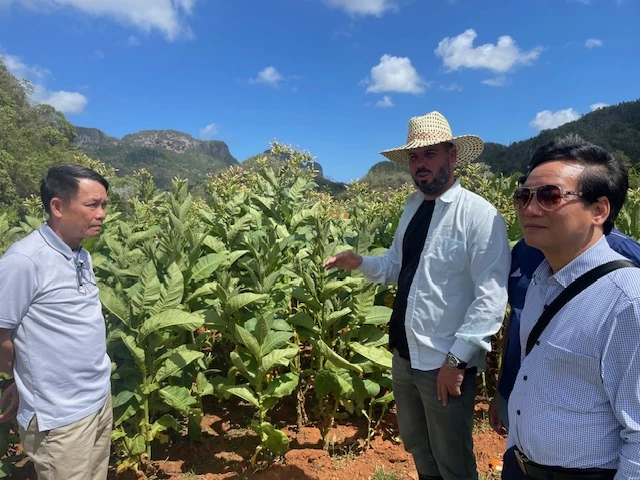
A corner of tobbaco farm in Cuba. Photo: M.T
J. Eric, our guide, pointed to his tobacco field on a nearby hill and explained that this small plot could yield over 100,000 plants. The tobacco is grown exclusively during the winter, from September to March. After harvest, the leaves are strung together and hung to dry in a thatched hut no chemicals are used. The leaves are left to cure naturally until they dry and mellow, ready for cigar production.
The tobacco farmers sell 90% of their raw tobacco to the government, which then ships it to Havana for cigar manufacturing. The remaining 10% can be used by the farmers to make cigars for sale on-site, although these cigars are sold without official labeling.
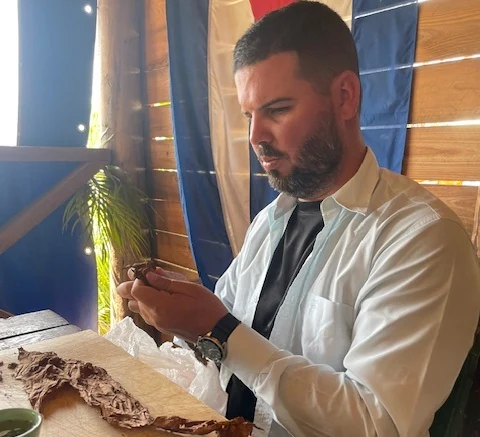
Javier Gonzales makes cigar for visitors. Photo: M.T
One of the most fascinating aspects of our visit was watching the process of introducing and rolling the handmade cigars. The man demonstrating this skill was Javier Gonzales, who has worked at the farm for over seven years and expressed a deep passion for his craft. With great care, he rolled each cigar, adding a touch of honey before offering them to us.
Javier shared his admiration for Vietnam and its people, speaking warmly and enthusiastically. He also recommended that, should we ever return to Cuba, we time our visit to coincide with the Cigar Festival, a celebration of Cuba’s cigar-making industry.
Javier Gonzales continued to talk, Luu Viet Hung, Resident Correspondent of the Vietnam News Agency’s Representative Office in Havana, pointed out the Panmal trees, which are abundant in Pinar del Rio. These trees are symbolic of Cuba, representing qualities of strength, uprightness, and invincibility. I jokingly asked Hung if it was true that only Cuban women could roll the best cigars. He smiled, but when he looked up and saw birds soaring in the sky, he explained that those were sung sung birds (hummingbirds), Cuba’s national bird. These birds are constantly flying, their wings beating tirelessly in mid-air, much like the revolutionary spirit of Cuba’s people.
Another Cuban specialty, widely sought after by visitors to Havana, is Havana rum - its rich aroma and strong flavor leave a lasting impression on anyone who tastes it, making it a perfect gift to bring home.
One noticeable difference in Cuba is that most of the foreign tourists we encountered, from the connecting flight from Paris to Havana’s José Martí International Airport, as well as in the tourist areas, were middle-aged or older. I believe they are part of a generation that experienced history firsthand and holds a deep admiration for President Fidel Castro and the Cuban Revolution. The highest concentration of tourists is found in Old Havana and the Caribbean beaches in Varadero.
In Havana, a stroll through the Old Quarter is equally interesting, with many buildings showcasing European architectural charm and colorful vintage cars on display along the streets for tourists to admire and take photos, though a fee is required for the owners.
We visited a restaurant named after the famous writer Ernest Hemingway. Interestingly, when we entered, local patrons graciously moved aside to allow us to take photos next to a statue of the author, known for his novella The Old Man and the Sea (1952), which solidified Hemingway’s reputation as the world’s leading writer at the time.
Our luck continued when we visited another restaurant decorated with antiques, where members of our group were welcomed by live Latin American music performed by street artists, with melodies that soared and echoed through the air. In Cuba, it’s said that music is present in every corner, from the humble spaces to the heights of artistic excellence.
During our beach experience in Varadero, located in Mayabeque Province, about 100 kilometers from Havana and the same distance from the U.S. state of Florida, we had the chance to watch sailors dive for lobsters. In addition to playfully interacting with hundreds of iguanas on the island, we were treated to a delightful seafood feast aboard the yacht. The crew served freshly caught lobsters and oysters, prepared right on board. The meal was so delicious that everyone couldn’t help but marvel at the experience, agreeing it was well worth the trip to this beautiful destination.
These are just the well-known tourist spots in Cuba. On this island, shaped like a crocodile with more than 500 years of development and home to more than 11 million people, daily life remains filled with challenges. Mr. Ngoc Anh, a representative of Vaglacera Corporation in Cuba, a Vietnamese company specializing in building materials, shared with us that the main reason for their investment in the country is based on friendship. He explained that manufacturing materials here is extremely difficult, especially due to the lack of reliable electricity.
“The power infrastructure, including the transmission lines and power plants, has not seen upgrades or replacement parts for decades, leading to frequent power outages. Sometimes, production lines are abruptly halted, reducing both productivity and the quality of materials,” said Ngoc Anh.
Having experienced many hardships themselves, our hosts in Cuba were quick to step in when challenges arose. On our very first day, a power outage occurred at our accommodation - the historic Hotel Nacional. Ngoc Anh kindly welcomed the entire delegation to his home for a meal of instant noodles and provided us with Cuban SIM cards to help everyone stay in touch with their families back home.
At the Vietnamese Embassy in Cuba, Ambassador Le Quang Long hosted a warm meeting with the delegation, offering insights into Cuba’s current difficulties and expressing solidarity with the Cuban people during this time.
We were deeply impressed by the Cuban people’s calm and resilient response to hardship. Despite ongoing economic challenges, Cuba continues to push forward with reforms aimed at revitalizing its economy, while remaining investment in the two sectors that have long earned the world’s respect - education and healthcare.
During our stay in beautiful Cuba, we were met with warmth and friendliness wherever we went. The moment people learned we were from Vietnam, they welcomed us with genuine affection.
There is still one place I hope to visit one day - Holguín Province. Quang Tri Province in Vietnam, the homeland of General Secretary Le Duan and Holguín, the birthplace of President Fidel Castro have recently signed a cooperation agreement to establish a friendship partnership. The first steps have already been taken, with both sides engaging in joint activities to support one another’s development.
What remains most deeply etched in our hearts from this trip is the image of a resilient nation that, despite ongoing hardships, stands tall with dignity. Wherever we went, we found smiling faces and heard music echoing through the towns - a country full of spirit, pride, and hope.
Adding to the uplifting spirit of each gathering in Cuba, journalist Nguyen Tien Vu, the Editor-in-Chief of Bac Ninh Newspaper and a member of our delegation, would often raise his voice in song, performing traditional Quan họ folk melodies. Through him, we learned more about the rich cultural traditions of this art form, which is still strictly preserved in 49 original Quan họ villages in the Kinh Bac region of Vietnam.
These communities maintain rigorous standards and rules, requiring male and female vocalists (lien anh, lien chi) to be well-versed in both technique and tradition. Many classic Quan họ songs remain beloved to this day, including “Von lieng em co 30 dong” (My Dowry is 30 Coins), “Moi nuoc moi trau” (Please Have Some Betel and Tea), “Ngoi tua song dao” (Sitting by the Peach Window), “Cay truc xinh” (The Graceful Bamboo), “Nguoi o dung ve” (Stay a Little Longer), and “Xe chi luon kim” (Threading the Needle).
Today, modern Quan họ performances are often staged during spring festivals, community events, tourism programs, and even in restaurants. I’ve promised myself to one day write a piece titled “Hearing Quan họ in Havana”, chronicling this unique cultural journey.
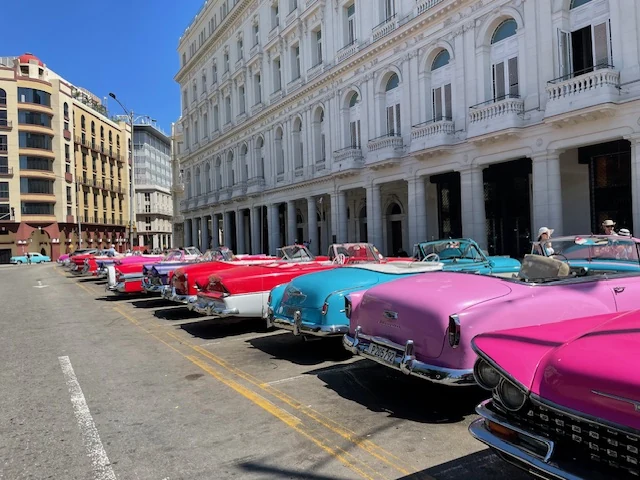
Colorful vintage cars on display along the streets. Photo: Minh Tu
I came up with the title while watching the Tropicana show in La Habana, an iconic piece of Cuba’s cultural heritage and one of the country’s longest-standing traditional art performances, dating back to the 1930s. Despite ongoing economic hardships, Cuba has managed to preserve this vibrant tradition, staging lavish open-air musical spectacles accompanied by light refreshments for guests.
The show exudes Latin American flair, with singers and dancers positioned throughout the venue, often interacting with the audience. Visitors are free to take souvenir photos with the performers, creating an open and festive atmosphere.
What caught my attention, though, was the contrast in the crowd: while the servers were Cuban, the audience consisted mostly of foreign tourists. The reason? The ticket price for the Tropicana show is relatively high, making it out of reach for many locals.Top of Form
As we prepared to leave Cuba, each member of our delegation carried home different emotions.
For Nguyen Duc Loi, Permanent Vice President of the Vietnam Journalists’ Association, the trip was a homecoming of sorts. It gave him the chance to revisit not only the country but also his alma mater - Havana University, where he once studied Spanish classical literature in the Faculty of Philology. He had also served as a resident correspondent for the Vietnam News Agency in several Latin American countries. Speaking to us, though it felt more like he was speaking to himself, he reflected: “Cuba’s support for Vietnam during the years of war, even long after peace was restored, was priceless. We can never fully repay such heartfelt solidarity.”
Indeed, we understood that the deep-rooted friendship between Vietnam and Cuba, forged through the invaluable support of the Cuban people and their leader Fidel Castro for Vietnam’s struggle for independence, has been cherished and nurtured by successive generations of both countries’ leaders. As Vietnam continues on its path of development, its people remain ever grateful for the sincere and selfless support extended by the Cuban leadership and people - and they share in the current hardships facing this nation.
More than six decades have passed, and time may bring many changes, but one thing remains unchanged: in the hearts of the Vietnamese and Cuban people, Fidel Castro stands as a symbol of revolutionary heroism, of the unwavering pursuit of freedom and happiness.
Though Cuba lies halfway across the globe, it has always felt close to the hearts of the Vietnamese people - a bond forged in loyalty, trust, and unshakable solidarity. No matter how the world may change, that steadfast friendship endures.
April, 2025
Minh Tu - Ngan Ha

QTO - The events aim to promote a culture of exercise and competitive sports, while also showcasing the province’s tourism potential and strengths.

QTO - In July, the central province of Quang Tri welcomes people from all parts of the country who silently come to this land to pay their tribute to...